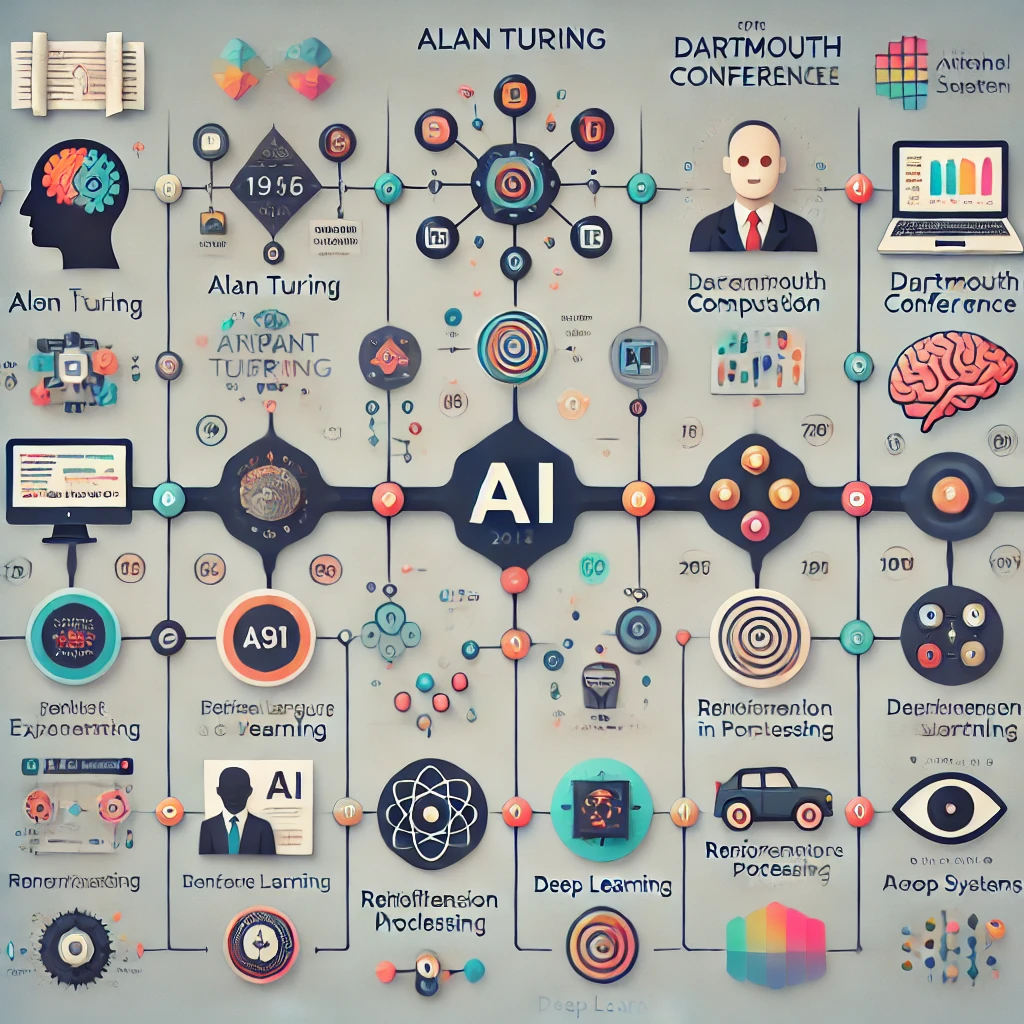
A timeline depicting the development of Artificial Intelligence (AI)
Introduction to Artificial Intelligence (AI)
Artificial Intelligence (AI) refers to the simulation of human intelligence in machines designed to think and act like humans. It encompasses a range of technologies that allow machines to learn from experience, adapt to new inputs, and perform tasks that would typically require human intelligence, such as problem-solving, language understanding, and decision-making. AI is becoming increasingly important across various sectors, including healthcare, finance, robotics, and entertainment, as it offers new ways to enhance efficiency, personalize services, and unlock innovative solutions to complex problems.
History of AI
The development of AI can be traced back to the mid-20th century, starting with pioneering figures like Alan Turing, who proposed the concept of machines capable of simulating any human activity, known as the Turing Test. This concept laid the foundation for future advancements in AI.
The Dartmouth Conference in 1956 is often considered the birthplace of AI as a formal academic discipline, where the term “artificial intelligence” was coined. In the following decades, researchers focused on creating rule-based systems, such as Expert Systems in the 1980s, which could mimic the decision-making abilities of a human expert within specific domains.
AI experienced several “winters,” or periods of reduced funding and interest, due to the limitations of early algorithms and computational resources. However, with the advent of more powerful computers and the development of machine learning (ML) and deep learning (DL) techniques, AI saw a resurgence in the 21st century, leading to breakthroughs in areas such as image recognition, natural language processing, and autonomous systems.
AI Providers and Their Strategies
Today, several key companies are leading the AI revolution. Each has a unique approach to AI, contributing to the rapid development of this technology.
- Google DeepMind: Known for its ground-breaking work in deep reinforcement learning, DeepMind made headlines with its development of AlphaGo, an AI that defeated world champions in the game of Go. Their focus is on solving general problems that could lead to breakthroughs in areas like healthcare and scientific discovery.
- OpenAI: OpenAI’s mission is to ensure that artificial general intelligence (AGI) benefits all of humanity. Their work includes developing language models like GPT and DALL-E, which have advanced the capabilities of natural language understanding, generation, and image creation. They emphasize openness and safety in AI development.
- IBM Watson: IBM Watson is well-known for its work in cognitive computing and natural language processing. IBM’s AI solutions are applied in areas like healthcare, where Watson helps doctors analyse medical data and make diagnoses, as well as in business processes to improve decision-making.
- Microsoft Azure AI: Through its Azure cloud platform, Microsoft provides a suite of AI tools and services designed to help businesses incorporate machine learning and AI into their operations. Their focus is on creating accessible AI solutions, emphasizing ethical AI practices and promoting transparency.
- Amazon Web Services (AWS) AI: AWS offers a range of AI services and machine learning tools through its cloud platform, enabling businesses to build, train, and deploy AI models at scale. AWS has been a leader in providing scalable, cost-effective AI solutions to organizations of all sizes.
State of the Art in AI
AI today is more advanced than ever, with significant breakthroughs in various subfields. Machine learning (ML) and deep learning (DL) have revolutionized the way AI systems are built, allowing machines to improve their performance based on data and experience.
- Natural Language Processing (NLP): NLP models like ChatGPT have made significant strides in understanding and generating human language, enabling more intuitive interactions between humans and machines.
- Computer Vision: AI-powered computer vision technologies have been integrated into various applications, from facial recognition to autonomous vehicles, enabling machines to “see” and interpret the world around them.
- Reinforcement Learning (RL): Reinforcement learning is a branch of ML where an agent learns by interacting with its environment, receiving rewards or penalties based on its actions. This approach has led to breakthroughs in robotics, gaming, and optimization problems.
- AI Ethics and Governance: As AI technologies become more integrated into society, there is growing emphasis on developing ethical guidelines, governance frameworks, and safety measures to ensure AI is used responsibly. Companies like OpenAI have been at the forefront of these discussions, focusing on the long-term impact of AGI and ensuring it benefits everyone.
Conclusion: A Roadmap for Understanding AI
To truly grasp the potential and nuances of AI, it’s essential to understand its evolution, current state, and future possibilities. Here’s a suggested path for further exploration:
- Start with Basics: Begin by exploring the foundational concepts of machine learning and natural language processing. These areas are pivotal for understanding modern AI systems like ChatGPT.
- Dive Deeper into History: Look into the historical figures and breakthroughs in AI, such as Turing’s work, the Dartmouth Conference, and the rise of expert systems. This will help provide context for today’s developments.
- Examine AI Ethics: As AI becomes more influential in society, understanding the ethical considerations around its use is crucial. Research AI governance frameworks, fairness, transparency, and biases in AI models.
- Explore Key Providers: Familiarize yourself with the major AI providers like Google DeepMind, OpenAI, and IBM Watson to understand their approaches to AI and how they are shaping the industry.
-
Focus on the Future: Stay updated on the latest developments in AI, such as reinforcement learning and autonomous systems. These areas represent the frontier of AI innovation.
Links
Here are links to the AI product pages of the main AI providers:
- Google DeepMind: https://deepmind.com
- OpenAI: https://openai.com
- IBM Watson: https://www.ibm.com/watson
- Microsoft Azure AI: https://azure.microsoft.com/en-us/services/cognitive-services/
- Amazon Web Services (AWS) AI: https://aws.amazon.com/machine-learning/




0 Comments